The NC Wildlife Resources Commission is stocking F1 hybrid bass into Lake Norman, Lake Gaston, and Jordan Lake annually as part of an evaluation project to determine the success of stocked fingerlings.
These experimental stockings aim to improve Largemouth Bass populations by increasing the quantity of trophy Largemouth Bass in reservoirs. The Commission will be closely evaluating F1 hybrid bass fingerling persistence, growth, and contribution to the Largemouth Bass population by collecting genetic and population data from electrofishing surveys and tournament weigh-ins. Program success will be evaluated until at least 2030 and compared across the three reservoirs, which have different levels of primary productivity, to determine future management strategies.
For a full description of the project, please view the Job Description.
Learn more about our funding partner, Bass Anglers for NC Lakes, Inc., or donate to the project.
Stocking
- 2020 – 2,000 F1 hybrid bass juveniles were stocked in Lake Norman
- 2021 – 40,000 F1 hybrid bass fingerlings (~2 in) were stocked in Lake Norman
- 2022 – 130,000 F1 hybrid bass fingerlings were stocked in Lake Norman
- 2023 – 130,000 F1 hybrid bass fingerlings were stocked into Lake Norman, 101,500 into Lake Gaston, and 65,110 into Jordan Lake
- 2024 – 227,500 F1 hybrid bass fingerlings were stocked into Lake Norman, 143,766 into Lake Gaston, and 92,225 into Jordan Lake
- 2025 - 146,250 146,250 F1 hybrid bass fingerlings were stocked into Lake Norman, 105,416 into Lake Gaston, and 59,287 into Jordan Lake
Fact Sheets and Publications
F1 hybrid bass are a first-generation cross between Largemouth Bass Micropterus nigricans and Florida Bass M. salmoides. These hybrids are thought to have “hybrid vigor”, allowing them to grow rapidly and attain a larger overall size than other forms of Largemouth Bass. Currently, the NC Wildlife Resources Commission (Commission) stocks F1 hybrid bass annually into three lakes across the Piedmont (Lake Norman, Lake Gaston, and Jordan Lake). These experimental stockings are part of a larger project aimed at evaluating the success of stocking F1 hybrids in lakes with three levels of primary productivity: oligotrophic, or low productivity (Lake Norman), mesotrophic (Lake Gaston), and eutrophic, or high productivity (Jordan Lake). The Commission began annually stocking F1 hybrid bass fingerlings into Lake Norman in 2021 and into Jordan Lake and Lake Gaston in 2023 at a target rate of 4–7 fish/acre (Table 1).
Project Objectives:
- Evaluate the survival and growth of F1 hybrid bass.
- Monitor the relative abundance of memorable-sized (20 inches or greater) stocked F1 hybrid bass in electrofishing surveys.
- Determine the relative abundance of memorable-sized F1 hybrid bass caught by anglers in fishing tournaments.
Methods:
- To monitor the growth and survival of stocked F1 hybrid bass, Commission biologists conduct annual electrofishing surveys where they weigh, measure, age, and take genetic samples of Largemouth Bass encountered. Annual electrofishing surveys began at Lake Norman in 2022 and at Jordan Lake and Lake Gaston in 2025.
- Genetic samples will also be collected at black bass fishing tournaments at each lake annually. Tournament sampling began at Lake Norman in 2025 and will begin at the other two lakes in 2027.
Results so far:
- Though the project is in the preliminary stages of evaluation, electrofishing surveys at Lake Norman from 2022 to 2024 revealed that 15 out of 424 fish surveyed (or 3.5 %) were stocked F1 hybrid bass individuals.
- While growth of F1 hybrid bass appears promising, sample sizes of recaptured stocked F1 hybrid bass are still too small to statistically evaluate differences between F1 hybrid bass and wild Largemouth Bass.
- Results from all 2025 electrofishing surveys and the Lake Norman tournament surveys are pending.
What’s Next:
- Continue stocking and conduct electrofishing surveys at all three lakes in 2026.
- Collect additional tournament samples at Lake Norman in 2026.
- Provide annual project updates as genetic analyses are completed.
Table 1.
The number of F1 hybrid bass fingerlings stocked by year and lake, with the stocking rate in parentheses.
| Year | Norman | Gaston | Jordan |
|---|---|---|---|
| 2021 | 40,000 (1.2) | ||
| 2022 | 130,000 (4.0) | ||
| 2023 | 130,000 (4.0) | 101,500 (5.0) | 65,110 (5.0) |
| 2024 | 227,500 (7.0) | 143,766 (7.0) | 92,225 (7.0) |
| 2025 | 146,250 (4.5) | 92,421 (4.5) | 59,287 (4.5) |
Contact your district fisheries biologist:
B. Everett Jordan Lake
Seth Mycko
District 5
336-534-0019
Lake Gaston
Kirk Rundle
District 3
252-903-7744
Lake Norman
Casey Joubert
District 6
910-729-0872
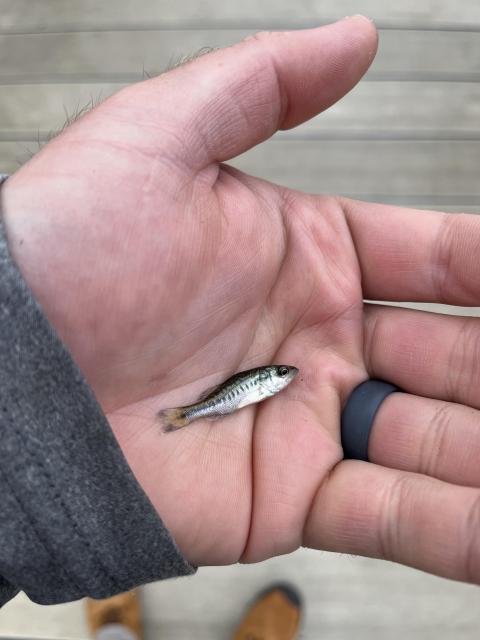

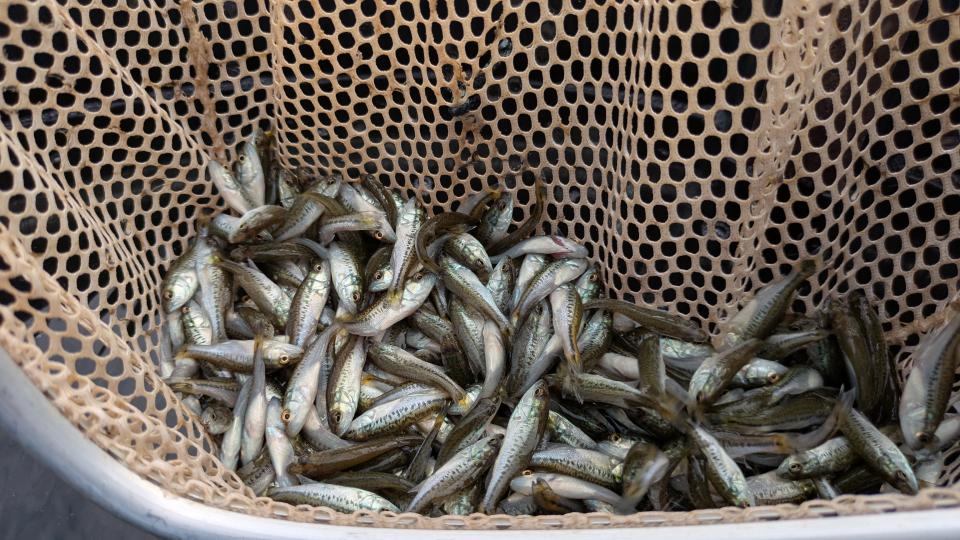
Highlights
- F1 hybrid Largemouth Bass are a first generation cross of a Northern Largemouth Bass and Florida Largemouth Bass. These hybrids have the potential for rapid growth.
- F1 hybrids will be stocked at B. Everett Jordan Reservoir, Lake Gaston, and Lake Norman for the next 4-5 years (2023 to 2027).
- Fin clips collected from NCWRC surveys and tournament weigh-ins will be genetically analyzed to determine the success of F1 hybrids. It is impossible to tell the difference between stocked F1 hybrids and other naturally spawned Largemouth Bass without using genetics.
- F1 hybrid Largemouth Bass success will be evaluated at these three reservoirs to determine future management.
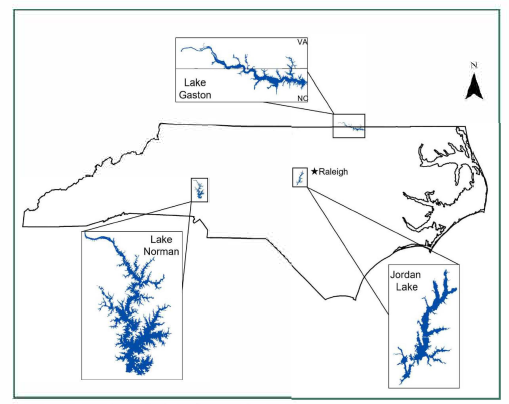
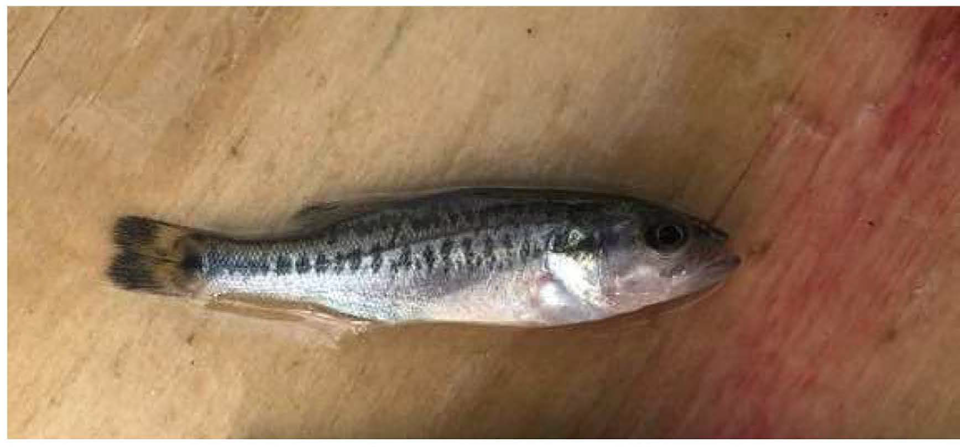
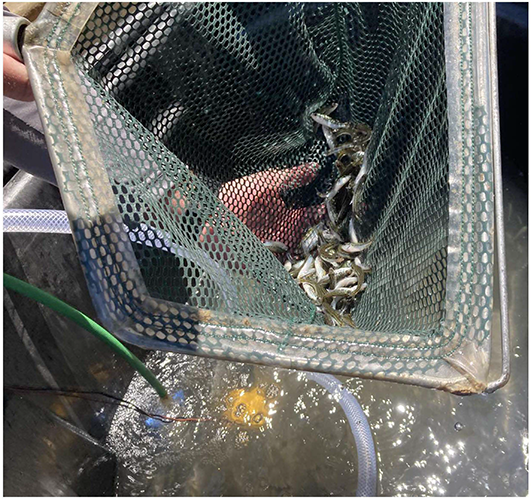
Anglers have advocated for the stocking of F1 hybrid Largemouth Bass (Micropterus salmoides floridanus X Micropterus salmoides salmoides) to augment Largemouth Bass populations and potentially increase the quantity of trophy black bass in reservoirs. F1 hybrids are a 50-50 cross between a pure Florida Largemouth Bass (Micropterus salmoides floridanus) and a pure Northern Largemouth Bass (Micropterus salmoides salmoides). This cross between the two strains of Largemouth Bass is believed to have "hybrid vigor". This vigor may allow F1 hybrids to grow rapidly and attain a larger overall size than other forms of Largemouth Bass. Offspring of a F1 hybrid will no longer be a cross between a pure Florida Largemouth Bass and a pure Northern Largemouth Bass, therefore the Commission must continue to stock F1 hybrids on a consistent basis to maintain the population.
F1 hybrids have been stocked in Lake Norman since 2021 and stocking at B. Everett Jordan Reservoir and Lake Gaston will begin in Summer 2023. The Commission's goal in stocking F1 hybrids will be to evaluate their persistence, growth potential, and ability to increase the overall quality of the existing Largemouth Bass fishery in reservoirs with different levels of productivity.
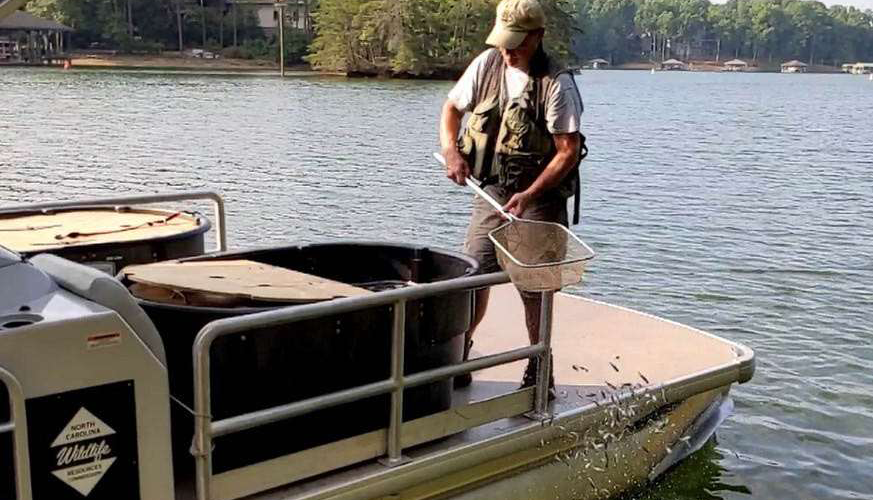
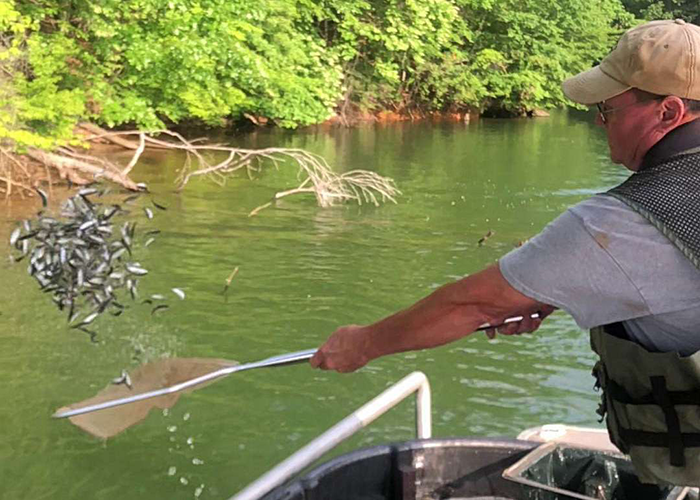
Project Objectives
- Determine the persistence and growth rates of stocked F1 hybrids in B. Everett Jordan Reservoir, Lake Gaston, and Lake Norman.
- Evaluate if environmental conditions at these reservoirs impact the quality of the F1 hybrid fisheries.
What's Next:
- Continue stocking F1 hybrids annually during the summers of 2023-2027.
- Complete electrofishing surveys and tournament collections annually to assess the impact of stocking until at least 2030.
For More Information:
B. Everett Jordan Lake
Seth Mycko
District 5 Fisheries Biologist
336-534-0019
Lake Gaston
Kirk Rundle
District 3 Fisheries Biologist
252-903-7744
Lake Norman
Casey Joubert
District 6 Fisheries Biologist
910-729-0872
Frequently Asked Questions
An F1 hybrid bass is a first-generation 50-50 cross between a pure Largemouth Bass and a pure Florida Bass.
F1 hybrid bass will be stocked by the Commission in Lake Norman, Lake Gaston, and Jordan Lake.
F1 hybrid bass are thought to have “hybrid vigor”, which may allow them to grow rapidly and attain a larger overall size than other forms of Largemouth Bass. The goal of stocking these fish is to increase the quantity and quality of trophy-sized bass in reservoirs.
In addition, some Largemouth Bass populations have been negatively impacted by the illegal introduction of Alabama Bass. Stocking F1 hybrid bass may help to augment certain populations that have been negatively affected. However, these stockings will not return Largemouth Bass populations to pre-invasion levels.
No, any offspring an F1 hybrid bass produces will no longer be a cross between a pure Florida and a pure Largemouth Bass. In fact, these hybrids very rarely occur in nature because most populations are a genetic mix between Largemouth Bass and Florida Bass and do not contain an abundance of pure Largemouth Bass and Florida Bass.
Because any offspring F1 hybrid bass produce will no longer be a cross between a pure Florida Bass and a pure Largemouth Bass, the Commission must stock F1 hybrid bass annually to maintain a population throughout the initial evaluation period and beyond.
Because current populations in North Carolina are already a genetic mix of Largemouth Bass and Florida Bass, biologists do not expect these stockings to drastically alter the genetic makeup of any populations. Biologists do not expect to see any negative impacts on the overall abundance, condition, or growth of the existing fisheries; however, the Commission will closely monitor populations, and stocking can be adjusted should any negative impacts arise.
The only way to identify an F1 hybrid bass is through genetic evaluation. On the surface, they look exactly like other Largemouth Bass in the reservoir.
The possibility of stocking F1 hybrid bass will largely depend on the successful evaluation of this current program as well as future budget and hatchery considerations.
The Commission purchases F1 hybrid bass fingerlings from private fish suppliers.
